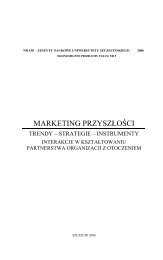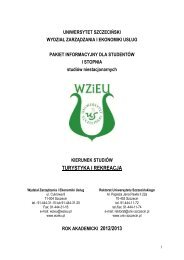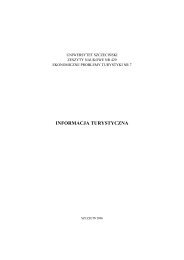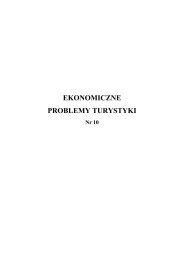Zeszyt naukowy - caÅoÅÄ - WydziaÅ ZarzÄ dzania i Ekonomiki UsÅug
Zeszyt naukowy - caÅoÅÄ - WydziaÅ ZarzÄ dzania i Ekonomiki UsÅug
Zeszyt naukowy - caÅoÅÄ - WydziaÅ ZarzÄ dzania i Ekonomiki UsÅug
You also want an ePaper? Increase the reach of your titles
YUMPU automatically turns print PDFs into web optimized ePapers that Google loves.
52<br />
Andris Klepers<br />
says, “social sciences in particular have a great role to play in explaining the contemporary<br />
processes of economic geography today” 1 .<br />
Another aspect here is communication across distances, which is encouraged<br />
by new technological tools, but also slowed down by the lack of a reliable road<br />
infrastructure and administrative boundaries.<br />
1. Theoretical Substantiation<br />
Clustering and networking is difficult to analyze because it is an amalgamation<br />
of geographic, social and psychological processes. There are different views on<br />
the size and form of the cluster of tourism services. Can we identify the size and<br />
approximate boundaries of the cluster? Probably it is not a major problem – because<br />
of the informal character of the cluster it is a subject to change. At the same time, it<br />
is important to see it more accurately defined when we speak about promotion of<br />
tourism destinations – what size of territory should we promote and how to organize<br />
that? Hence, social networking and clustering can be perceived as one of the most<br />
useful insights for organising tourism destinations on a local scale. Defining the<br />
destination, Davidson and Maitland (1997 2 ) have mentioned an “active private sector”<br />
as one of the important characteristics for recognizing tourism destinations.<br />
Hall (2000 3 ) added direction to that activity of private sector advising to ability of<br />
supporting tourism marketing and planning initiatives.<br />
Post-structuralist approach to places and spaces of tourism considers their<br />
presentation, production and consumption to be a socio-cultural process (Darcy &<br />
Small, 2008 4 ). Place is not something “out there” but it is socially constructed and<br />
therefore unstable, fluid and not fixed (Blunt & Rose, 2004 5 ). Discussion about<br />
measurement and borders of any spatial element becomes unnecessary when the<br />
concept of space is a fuzzy logic element with vague boundaries. That is supported<br />
by Michael (2007 6 ), who calls perceptions of regionality “artificial”. However, from<br />
1<br />
E.W. Schamp, Vernetzte Produktion. Industriegeographie aus institutioneller Perspektive,<br />
Darmstadt: Wissenschaftliche Buchgesellschaft, Darmstadt 2000, p. 5.<br />
2<br />
R. Davidson, R. Maitland, Tourism destinations, Hodder & Stoughton, London 2007.<br />
3<br />
C.M. Hall, Tourism Planning. Policies, Processes and Relationships, Pearson Education,<br />
Singapore 2000.<br />
4<br />
S. Darcy, J. Small, Theorizing Precincts: Disciplinary Perspectives, in: City Spaces –<br />
Tourist Places: Urban Tourism Precincts, B. Hayllar, T. Griffin, D. Edwards (eds), Elsevier,<br />
Oxford 2008, pp. 63–93.<br />
5<br />
A. Blunt, G. Rose, Introduction: women’s colonial and postcolonial geographies, in:<br />
Writing Women and Space: Colonial and Postcolonial Geographies, A. Blunt, G. Rose (eds), The<br />
Guilford Press, New York 1994, pp. 1–25.<br />
6<br />
E. Michael, Micro-Clusters and Networks: The Growth of Tourism (1st ed.), Elsevier<br />
Science, Oxford 2007.

















